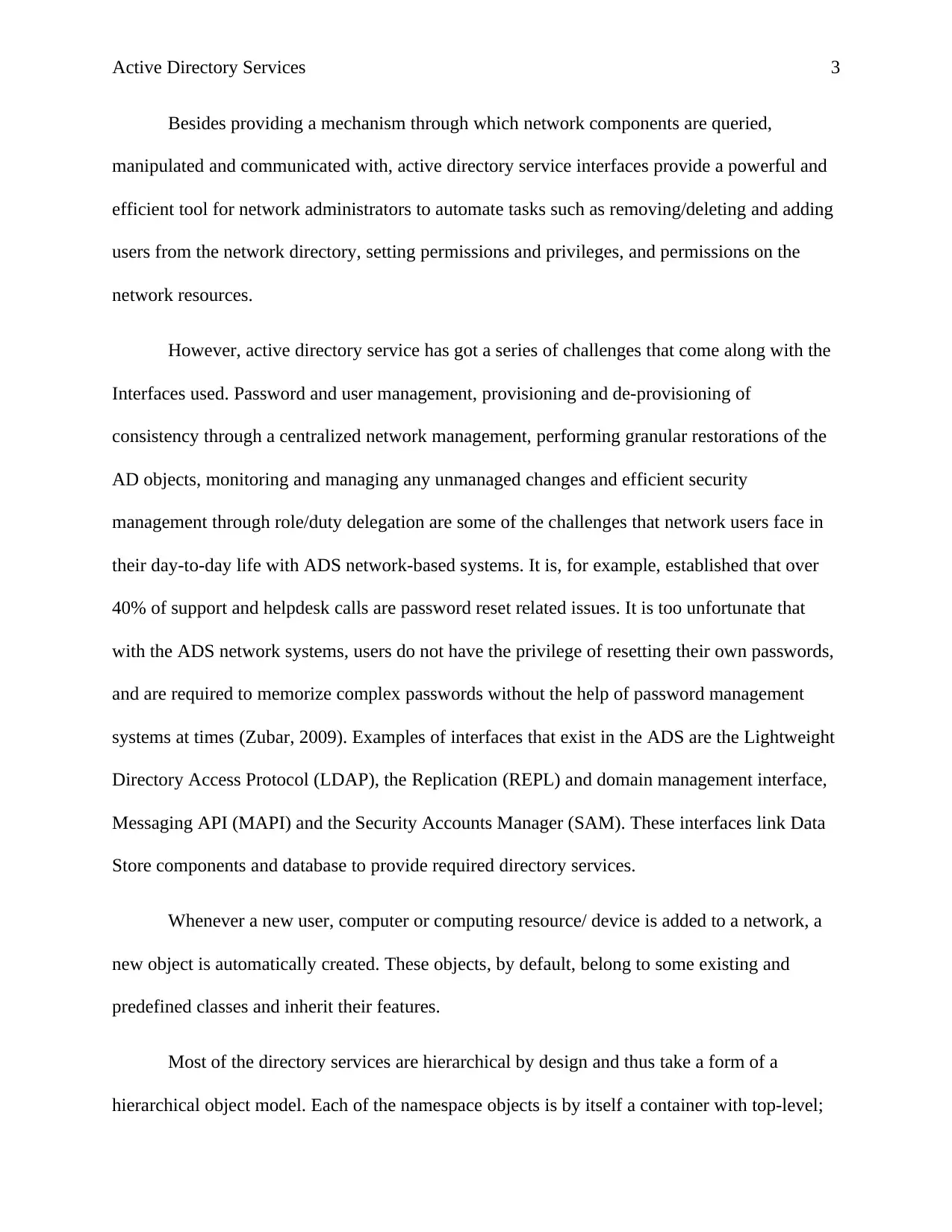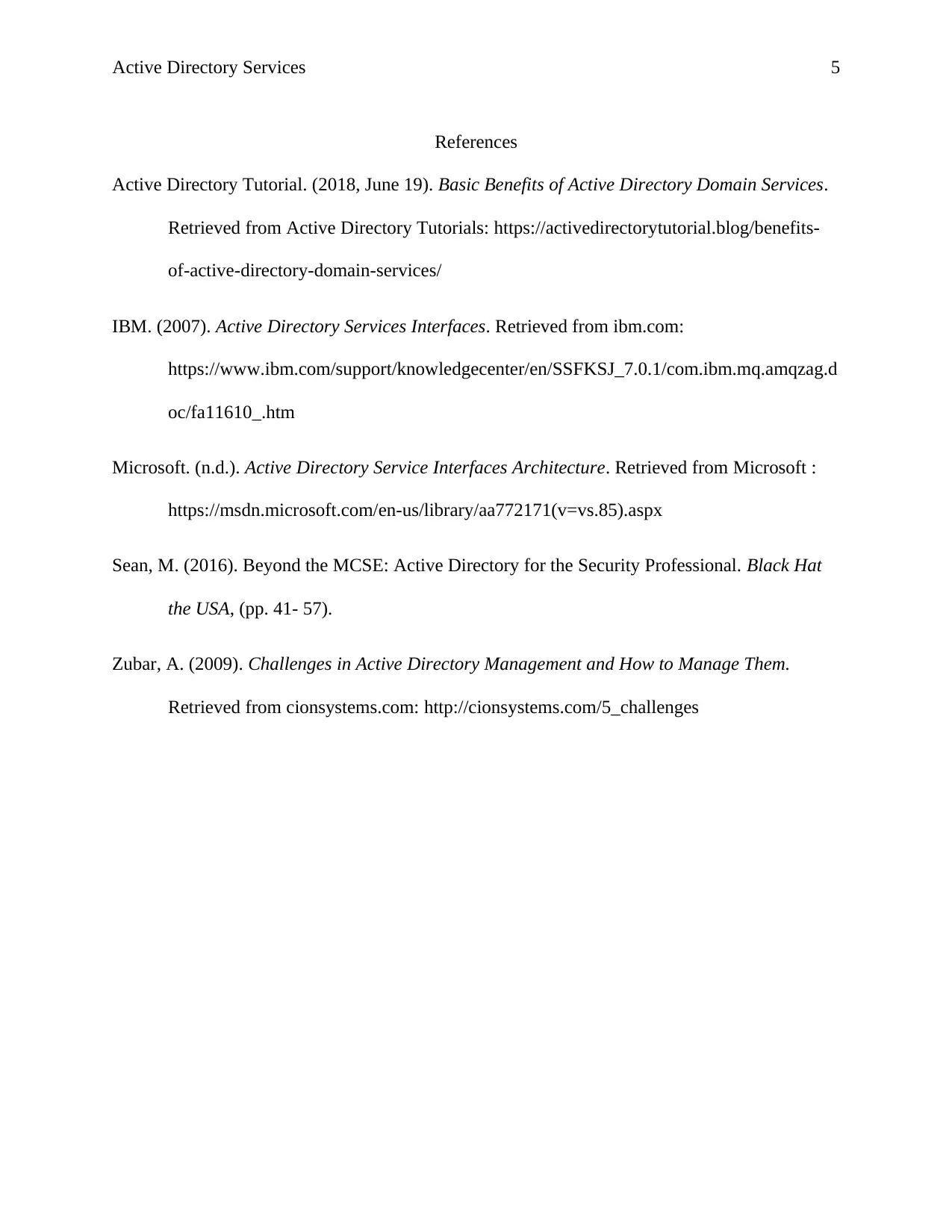Active Directory Services: Analyzing Interfaces and Network Management
VerifiedAdded on 2023/06/10
|5
|1026
|346
Report
AI Summary
This report provides an overview of Active Directory Services (ADS) within a networking environment, highlighting its role as a registry for user, group, and resource information. It details the advantages of ADS, such as centralized network resource management and single sign-on access, and explores the use of Active Directory Service Interfaces (ADSIs) for querying and manipulating directory service objects. The report also addresses challenges associated with ADS, including password management, user provisioning, and security concerns. Key interfaces like LDAP, REPL, MAPI, and SAM are mentioned, along with the hierarchical object model and core architectural components like objects, domains, and organizational units. The document concludes by referencing various sources that provide further information on Active Directory Services and its interfaces.

Running head: Active Directory Services 1
Active Directory Services
Name of the Student:
Name of the Institution:
Active Directory Services
Name of the Student:
Name of the Institution:
Paraphrase This Document
Need a fresh take? Get an instant paraphrase of this document with our AI Paraphraser

Active Directory Services 2
Active Directory Services
In a networking environment, Active Directory Services refers to a registry in which
information regarding all users, groups, printers and network shared resources among other
information is stored (Sean, 2016). This information is stored in Active Directory Database, with
each of the records considered as an object with some associated attributes. Active Directory
provides such services as storage of directory data and availing such data to network
administrators and users- depending on their assigned roles, permissions and privileges.
Active directory services brings the following advantages to an organization. First, it
serves as a single point from where administrators manage network resources and associated
objects. As such organizations manage their networks based on their organizational models,
business models or specific functions needed by the network. Second, the system provides a
single access point for all network resources by using a single sign in, through which all
resources located within the network domain are accessed. Any single user has to sign in to the
network just once, and will in the next times be simply required to access network resources in
accordance to their assigned privileges and associated permissions (Active Directory Tutorial,
2018).
System developers and administrators query and manipulate the directory service objects
through Active Directory Service Interfaces. The ADSIs are defined as a communication path
through which users and objects communicate with each other. The interfaces allow client
applications to use common set of Component Object Model (COM) interface through which
communication and control with and of any applications are implemented (IBM, 2007). Through
ADSI, directory services abstract network capabilities thus presenting to end users a set of
directory service interface for managing shared network resources.
Active Directory Services
In a networking environment, Active Directory Services refers to a registry in which
information regarding all users, groups, printers and network shared resources among other
information is stored (Sean, 2016). This information is stored in Active Directory Database, with
each of the records considered as an object with some associated attributes. Active Directory
provides such services as storage of directory data and availing such data to network
administrators and users- depending on their assigned roles, permissions and privileges.
Active directory services brings the following advantages to an organization. First, it
serves as a single point from where administrators manage network resources and associated
objects. As such organizations manage their networks based on their organizational models,
business models or specific functions needed by the network. Second, the system provides a
single access point for all network resources by using a single sign in, through which all
resources located within the network domain are accessed. Any single user has to sign in to the
network just once, and will in the next times be simply required to access network resources in
accordance to their assigned privileges and associated permissions (Active Directory Tutorial,
2018).
System developers and administrators query and manipulate the directory service objects
through Active Directory Service Interfaces. The ADSIs are defined as a communication path
through which users and objects communicate with each other. The interfaces allow client
applications to use common set of Component Object Model (COM) interface through which
communication and control with and of any applications are implemented (IBM, 2007). Through
ADSI, directory services abstract network capabilities thus presenting to end users a set of
directory service interface for managing shared network resources.

Active Directory Services 3
Besides providing a mechanism through which network components are queried,
manipulated and communicated with, active directory service interfaces provide a powerful and
efficient tool for network administrators to automate tasks such as removing/deleting and adding
users from the network directory, setting permissions and privileges, and permissions on the
network resources.
However, active directory service has got a series of challenges that come along with the
Interfaces used. Password and user management, provisioning and de-provisioning of
consistency through a centralized network management, performing granular restorations of the
AD objects, monitoring and managing any unmanaged changes and efficient security
management through role/duty delegation are some of the challenges that network users face in
their day-to-day life with ADS network-based systems. It is, for example, established that over
40% of support and helpdesk calls are password reset related issues. It is too unfortunate that
with the ADS network systems, users do not have the privilege of resetting their own passwords,
and are required to memorize complex passwords without the help of password management
systems at times (Zubar, 2009). Examples of interfaces that exist in the ADS are the Lightweight
Directory Access Protocol (LDAP), the Replication (REPL) and domain management interface,
Messaging API (MAPI) and the Security Accounts Manager (SAM). These interfaces link Data
Store components and database to provide required directory services.
Whenever a new user, computer or computing resource/ device is added to a network, a
new object is automatically created. These objects, by default, belong to some existing and
predefined classes and inherit their features.
Most of the directory services are hierarchical by design and thus take a form of a
hierarchical object model. Each of the namespace objects is by itself a container with top-level;
Besides providing a mechanism through which network components are queried,
manipulated and communicated with, active directory service interfaces provide a powerful and
efficient tool for network administrators to automate tasks such as removing/deleting and adding
users from the network directory, setting permissions and privileges, and permissions on the
network resources.
However, active directory service has got a series of challenges that come along with the
Interfaces used. Password and user management, provisioning and de-provisioning of
consistency through a centralized network management, performing granular restorations of the
AD objects, monitoring and managing any unmanaged changes and efficient security
management through role/duty delegation are some of the challenges that network users face in
their day-to-day life with ADS network-based systems. It is, for example, established that over
40% of support and helpdesk calls are password reset related issues. It is too unfortunate that
with the ADS network systems, users do not have the privilege of resetting their own passwords,
and are required to memorize complex passwords without the help of password management
systems at times (Zubar, 2009). Examples of interfaces that exist in the ADS are the Lightweight
Directory Access Protocol (LDAP), the Replication (REPL) and domain management interface,
Messaging API (MAPI) and the Security Accounts Manager (SAM). These interfaces link Data
Store components and database to provide required directory services.
Whenever a new user, computer or computing resource/ device is added to a network, a
new object is automatically created. These objects, by default, belong to some existing and
predefined classes and inherit their features.
Most of the directory services are hierarchical by design and thus take a form of a
hierarchical object model. Each of the namespace objects is by itself a container with top-level;
⊘ This is a preview!⊘
Do you want full access?
Subscribe today to unlock all pages.

Trusted by 1+ million students worldwide

Active Directory Services 4
root nodes for every server, domain and any other directory system objects as may be defined by
respective directory. The root-node, found within each object includes an ADSI schema
container object that defines all features associated with the namespace provider (Microsoft,
n.d.). The objects that define the basic architecture for active directory service networks are
objects, their naming conventions, object publishing, and domains- including trees, trusts, forests
and organizational units. The COM objects are logically connected set of properties and
methods. The functionalities if the interfacing is provided through the IADs object- used to
identify objects by supplying objects metadata including definitions and schema for ADSI,
IADsContainer that is used for object management and detection, including creation, deletion,
bridging, copying and moving objects interface, IADsPropertyList, IDirectoryObject and
IUnknown elements.
Active Directory System is made up of three components- the Locator, Active Directory
domain names found in the DNS, and the DNS objects. The locator is implemented in the net
login service and helps clients and network users to locate domain controllers. For every AD
domain is a DNS name. By default, computers and domains are represented as objects and nodes
in AD and DNS respectively.
root nodes for every server, domain and any other directory system objects as may be defined by
respective directory. The root-node, found within each object includes an ADSI schema
container object that defines all features associated with the namespace provider (Microsoft,
n.d.). The objects that define the basic architecture for active directory service networks are
objects, their naming conventions, object publishing, and domains- including trees, trusts, forests
and organizational units. The COM objects are logically connected set of properties and
methods. The functionalities if the interfacing is provided through the IADs object- used to
identify objects by supplying objects metadata including definitions and schema for ADSI,
IADsContainer that is used for object management and detection, including creation, deletion,
bridging, copying and moving objects interface, IADsPropertyList, IDirectoryObject and
IUnknown elements.
Active Directory System is made up of three components- the Locator, Active Directory
domain names found in the DNS, and the DNS objects. The locator is implemented in the net
login service and helps clients and network users to locate domain controllers. For every AD
domain is a DNS name. By default, computers and domains are represented as objects and nodes
in AD and DNS respectively.
Paraphrase This Document
Need a fresh take? Get an instant paraphrase of this document with our AI Paraphraser

Active Directory Services 5
References
Active Directory Tutorial. (2018, June 19). Basic Benefits of Active Directory Domain Services.
Retrieved from Active Directory Tutorials: https://activedirectorytutorial.blog/benefits-
of-active-directory-domain-services/
IBM. (2007). Active Directory Services Interfaces. Retrieved from ibm.com:
https://www.ibm.com/support/knowledgecenter/en/SSFKSJ_7.0.1/com.ibm.mq.amqzag.d
oc/fa11610_.htm
Microsoft. (n.d.). Active Directory Service Interfaces Architecture. Retrieved from Microsoft :
https://msdn.microsoft.com/en-us/library/aa772171(v=vs.85).aspx
Sean, M. (2016). Beyond the MCSE: Active Directory for the Security Professional. Black Hat
the USA, (pp. 41- 57).
Zubar, A. (2009). Challenges in Active Directory Management and How to Manage Them.
Retrieved from cionsystems.com: http://cionsystems.com/5_challenges
References
Active Directory Tutorial. (2018, June 19). Basic Benefits of Active Directory Domain Services.
Retrieved from Active Directory Tutorials: https://activedirectorytutorial.blog/benefits-
of-active-directory-domain-services/
IBM. (2007). Active Directory Services Interfaces. Retrieved from ibm.com:
https://www.ibm.com/support/knowledgecenter/en/SSFKSJ_7.0.1/com.ibm.mq.amqzag.d
oc/fa11610_.htm
Microsoft. (n.d.). Active Directory Service Interfaces Architecture. Retrieved from Microsoft :
https://msdn.microsoft.com/en-us/library/aa772171(v=vs.85).aspx
Sean, M. (2016). Beyond the MCSE: Active Directory for the Security Professional. Black Hat
the USA, (pp. 41- 57).
Zubar, A. (2009). Challenges in Active Directory Management and How to Manage Them.
Retrieved from cionsystems.com: http://cionsystems.com/5_challenges
1 out of 5
Related Documents
Your All-in-One AI-Powered Toolkit for Academic Success.
+13062052269
info@desklib.com
Available 24*7 on WhatsApp / Email
![[object Object]](/_next/static/media/star-bottom.7253800d.svg)
Unlock your academic potential
Copyright © 2020–2025 A2Z Services. All Rights Reserved. Developed and managed by ZUCOL.



